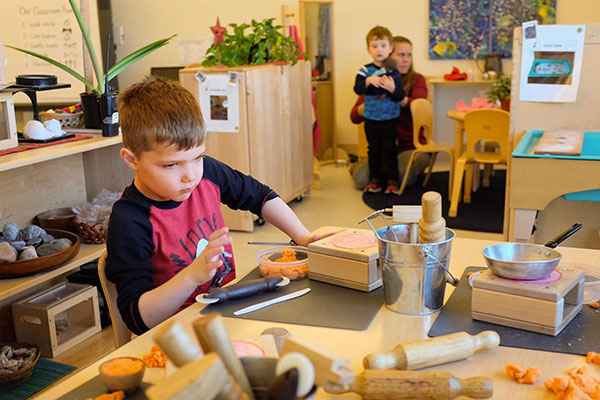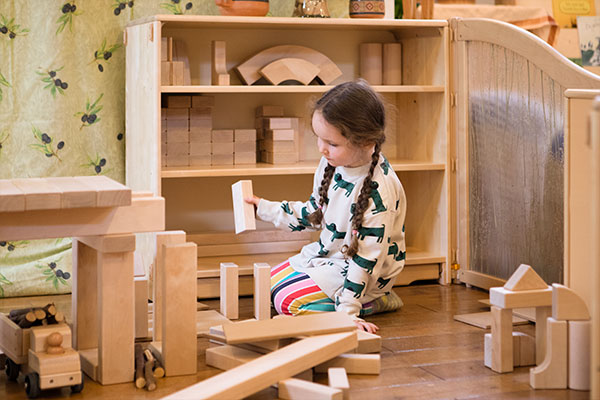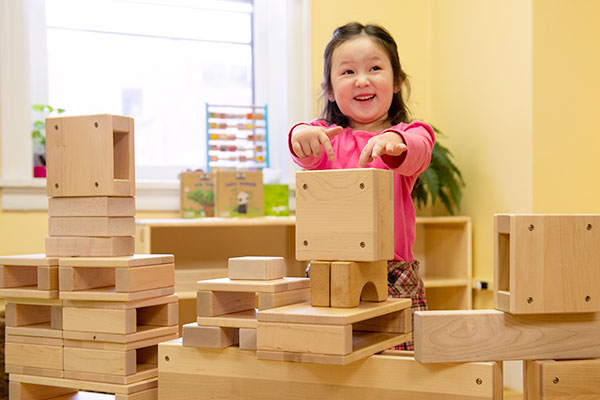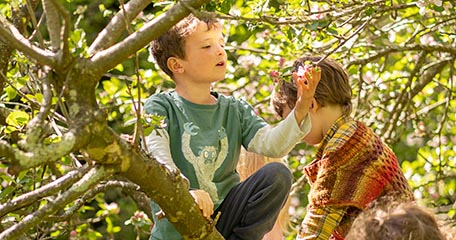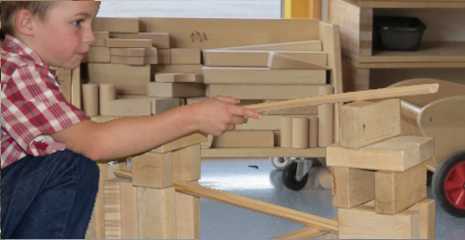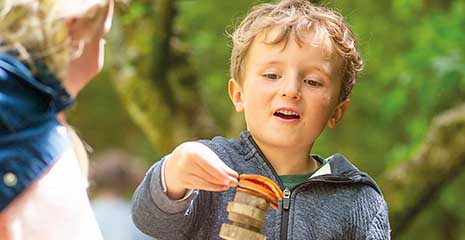Building with blocks
Opportunities for learning
| June 2009Entering a second grade classroom, it is easy to determine what the children are learning. The schedule tells us when there will be maths, reading, writer’s workshop, science, social studies, and art. The charts around the room give evidence of and add detail to these categories; textbooks with their printed pages add further detail and content.
But how do we orient ourselves in relation to knowledge and learning when we enter a classroom filled with materials and active young children? What is revealed when we look at a child painting a bold design in vivid colours; another squeezing and rolling clay; a small group building a house with unit blocks; a trio preparing a snack with a teacher; a child absorbed in matching geometric shapes next to one drawing lines going in all directions to represent rain falling from the sky; or the busy group packing picture books, food, and the baby as they start their trip on the train they have made with hollow blocks?
Where are the categories that name knowledge areas, the textbooks that inform and guide what we see in this busy, active group? In early childhood education, our textbooks are the materials we offer children – the blocks, paint, crayons, paper, water, sand, clay, and manipulatives that fill our classrooms. Rather than books of printed pages with facts and information, our texts are more like outlines, openings to learning, entry points into the ordered knowledge of the adult world. In the hands of children, the materials we offer become tools with which they give form to and express their understanding of the complex world in which they live.
As they imaginatively experiment with materials – with the fluidity of paint and water, the unyieldingness and durability of wood, the soft malleability of clay – they bring their thoughts and feelings, and questions, to their activities. And in the process of experimenting and discovering, of giving form to and transforming their experiences in play, they author their own texts, create meanings, and make sense of their often mysterious and complex world of which they are a part.
What learning opportunities are we offering children with the unit blocks designed by Caroline Pratt? As tools, what may children discover in using them? What texts may they author with blocks? While children’s experience with blocks will be determined in large measure by the nature of the invitation we offer – the space allocated to blocks, the time offered in which to use them, the number and variety of blocks, the supplementary materials, and our interest and understanding – we can speak in general terms of the possibilities and opportunities for learning that blocks may offer young children.
Three year old Maria looks at the block shelves and takes a unit block in each hand. Carefully, she places each on its side with the ends meeting. Back to the shelf for two more units. As the line of blocks grows, Maria claps with delight. Next to her, Maya places one square block on top of another. Her wobbly tower grows until it topples over to Maya’s puzzled surprise.
Four year old Maritza and Derick are working together. They begin by placing two double units on the floor and then two more across them. In a criss-cross pattern of double units, their structure grows quickly. At a certain point, Maritza’s attention turns to adding cylinders in front of the tall building. Derick is absorbed in carefully adding unit blocks to each “floor” of the tall structure. Without conversation, each continues to add blocks to his and her structure and also decorations – coloured one inch cubes, a piece of cloth, string, and a wooden cow on top of the tall structure.
In a group of fives, James, Grace, Michael, and Esperanza are discussing the hospital they are going to build. Michael has decided to make a garage for the ambulance. The others go back to get blocks to make “the place where the doctor gives you a shot” and where “they fix your bones.” On the way to the shelves, James adds, “I’ll make the place where you get coffee and ice cream.” Grace looks at him in confusion.
As they experiment with blocks, Maria and Maya have entered the area of science as they learn about physical laws and reality, about balance and the law of gravity (objects fall down). With time and the experience of many hours of handling blocks, they will learn, as Derick and Maritza have, how to make a steady building, how to balance weight equally, about three-dimensionality, and about self in space. And they will learn about the nature of wood: you can’t bend it; it doesn’t break; no matter what you construct, blocks always retain their original shape.
In the three vignettes, we have examples of social development in play – solitary, parallel, and cooperative. Blocks accommodate the developmental level of the child and also the mood of the moment. For example, while capable of cooperative play, there are days when a child may wish to build alone. And it is in the block area that many and varied opportunities exist for moral thinking. Negotiation, compromise, cooperation, caring and consideration, and the balance of individual and group rights are not abstract concepts but concrete, lived experiences as children encounter and work to resolve the dilemmas that arise when space and materials are finite and must be shared. Language flourishes in this setting as children talk about their structures, explain the workings of their buildings, share information (and misinformation), and see the world from the perspective of another in conversation.
Block building poses further problem solving for children. There are architectural problems: How do you make the road turn here without a bump? Why does the bridge keep falling? While these problems are posed here in words, for the block builder they exist in the realm of the concrete. The problems are experienced through the feel of the bump and the sound of block falling. Initially, these problems are worked on through trial and error. Then, from an expanding background of experience, children arrive at an intuitive, wordless grasp of the problem that leads to action. It is from the long stretches of time spent in trial and error and action solving that children arrive at the point where they announce with conviction, “Well, if we add the triangle here, see, then the bridge will be more steady.”
The harmonious relationship between and among blocks based on the size of the unit blocks makes this material a natural for learning about maths which is about relationships. Blocks become tools that invite mathematical thinking. Patterns, geometric shapes, part-whole relationships, fractions, adding, dividing, subtracting are all experienced and practised naturally in the process of building.
Going back to the three vignettes, we see Maria and Maya experimenting with and learning about the potential and limitations of wooden blocks. They are finding out both what they can do and also what does this (the block) do. In contrast, Derick and Maritza have mastered balance and steadiness; now they work intentionally to create forms that please them aesthetically. At this stage of block building, children often create breathtaking structures – structures they do not necessarily use in dramatic play. At this stage of building, it is the process of creating a structure that brings satisfaction to the child rather than a focus on representation.
It is the block building and dramatic play of James, Grace, Michael, and Esperanza that symbolisation and representation appear. From their shared information and what some may have experienced, the children bring what they know and what they feel about hospitals to their building and dramatic play. In Grace’s concept of hospital, there is no “coffee and ice cream” as there is for James, who has been in a hospital’s cafeteria. For the children, their task is to translate ideas, images, and feelings into visible forms. Blocks are the tools with which the children tell us the meanings they have created and the understandings they have achieved. As we observe their play, we find direction for our planning in social studies. What questions will expand their thinking? What trips should we take? Are supplementary materials needed? What books may add detail and information?
In symbolically recreating their world through their block building and dramatic play, children are also strengthening the skills and abilities needed for accepting and using the social symbol systems of language and mathematics. And, in such play, they often move even closer to actual words and numbers as they create signs for their buildings with their invented spelling, such as “Kasle,” “Spas Stashn-2.”
The learning opportunities available in block building, and the dramatic play accompanying it, are many and varied. What has been presented is a beginning to which each of us may add from our observations of children. What has been said of learning opportunities extends to the adults who work with children. In observing and supporting their play, we are offered openings into the children’s worlds, opportunities to see the meanings they have created, the questions with which they are struggling, and the stories they are boldly and imaginatively authoring about the world and their place in it.
Reprinted with permission from Child Care Information Exchange, (1995) Block Play: Beginnings Workshop. May/June 36–38.

